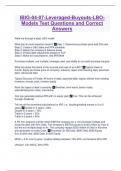Tentamen (uitwerkingen)
IBIG-04-07-Leveraged-Buyouts-LBO-Models Test Questions and Correct Answers
- Vak
- Instelling
Walk me through a basic LBO model What are its most important levers? Step 1: Determine purchase price and D/E ratio Step 2: Create a S&U table and PPA schedule Step 3: Adjust the company's balance sheet Step 4: Project debt repayments based on FCF Step 5: Make exit assumptions, find IRR/MoM Purc...
[Meer zien]




